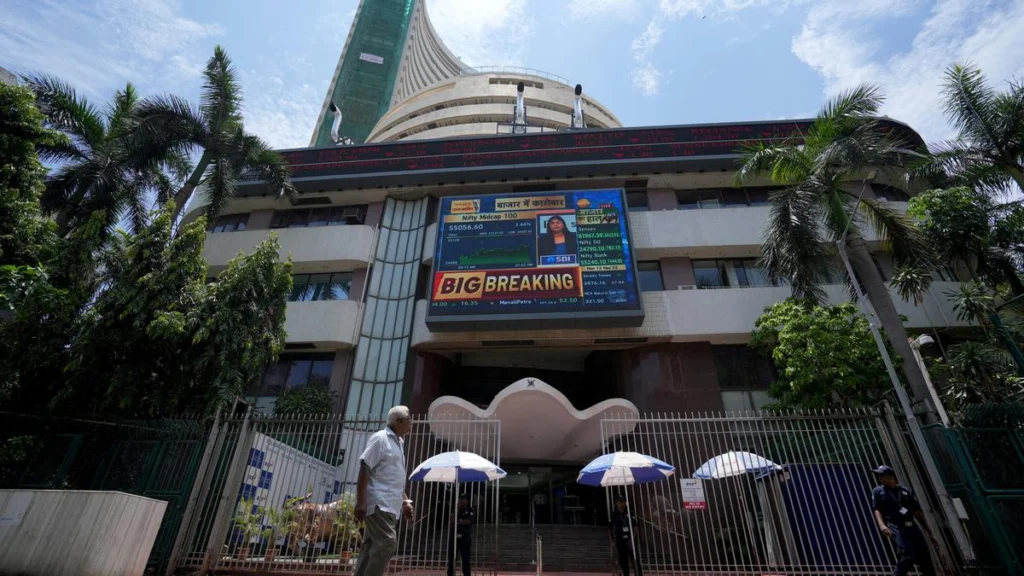Markets inch higher in opening session; later turn flat amid volatile trends

Markets Inch Higher, Then Turn Flat Amid Volatility
Indian stock markets experienced a volatile trading session on Friday, July 4, 2025. Benchmark indices, including the Sensex and Nifty, saw a modest opening gain. However, by the end of the day, the markets turned flat as investor sentiment wavered.
A Positive Start
The Indian markets opened with slight gains, buoyed by positive cues from global markets. The U.S. stock markets had rallied in the previous session, and this optimism spilled over into Indian markets. Investors focused on buying bank stocks, which provided support to the early gains.
The financial sector, especially large-cap banks, played a key role in the market’s upward movement. Strong earnings expectations and growth projections for the banking sector led to buying interest. Additionally, the rally in U.S. markets helped lift investor sentiment.
A Shift Toward Caution
Despite the positive start, the momentum faded as the session progressed. As the day unfolded, investors remained cautious. The uncertainty surrounding India’s upcoming trade deal with the U.S. kept many on the sidelines. This hesitation led the indices to turn flat by the afternoon.
Investor caution also stemmed from global uncertainties, particularly concerns over inflation, rising interest rates, and geopolitical tensions. These factors kept market participants from making significant moves.
FIIs and DIIs Activity
One of the key factors influencing market sentiment was the mixed activity of Foreign Institutional Investors (FIIs) and Domestic Institutional Investors (DIIs). On Thursday, July 3, 2025, FIIs sold equities worth ₹1,481.19 crore, continuing a trend of profit-booking. This selling pressure weighed on the market, especially in the face of global uncertainty.
However, DIIs stepped in to support the market, buying stocks worth ₹1,333.06 crore. Domestic investors, including mutual funds, have continued to show confidence in the Indian market. Their support helped cushion the impact of FIIs’ selling, but the market still showed a lack of direction.
Waiting for Clarity on Trade Deal
Much of the caution in the market was linked to the uncertainty around India’s trade deal with the U.S. The deal, expected to be finalized soon, could have significant implications for various sectors in India. While the agreement could benefit the economy by improving access to the U.S. market, concerns remain about potential concessions that India may need to make.
As a result, investors are adopting a “wait-and-see” approach, refraining from large investments until there is more clarity on the terms of the trade agreement.
Sector Performance: Banking Leads, But Others Struggle
Banking stocks saw the most buying interest during the session. The Nifty Bank index rose in early trade, supported by the positive outlook for financials. Major banks like HDFC Bank, ICICI Bank, and Axis Bank were among the top performers.
However, other sectors struggled. While banks and financial stocks were buoyant, sectors like metals, real estate, and IT faced challenges. The metal sector, which had performed well in recent months due to rising demand, lost steam amid renewed global growth concerns. Similarly, IT stocks turned flat after a brief rise, as concerns over global economic stability weighed on investor sentiment.
Global Economic Concerns
A key reason behind the market’s volatility was the broader global economic environment. The U.S. Federal Reserve and other central banks have adopted more hawkish stances in recent months, signaling that inflation remains a top priority. Rising interest rates could slow down global economic growth, which in turn may affect corporate earnings and stock prices.
Geopolitical risks, such as the ongoing Russia-Ukraine conflict and the potential for further tensions in the Middle East, have added to global market uncertainties. These concerns have caused investors to remain cautious, particularly in emerging markets like India.
Outlook for the Indian Market
Looking ahead, the outlook for the Indian stock market remains uncertain. While DIIs continue to provide support, the overall sentiment has been subdued due to external factors like global inflation and the U.S. trade deal with India. The volatility seen in recent sessions is expected to continue, with investors closely watching any developments in these areas.
The upcoming trade deal with the U.S. will likely be a major driver for market sentiment in the short term. If the deal is favorable, it could provide a boost to certain sectors and help improve investor confidence. On the other hand, any perceived setbacks or concessions could lead to market pullbacks.
Conclusion: Navigating a Volatile Market
On July 4, 2025, Indian markets witnessed a volatile trading session. While the indices initially gained on the back of positive global cues and buying in banking stocks, the market lost momentum as investor sentiment turned cautious. FIIs continued to sell, while DIIs stepped in to support the market. The uncertainty surrounding the India-U.S. trade deal added to the overall caution.
The market is expected to remain volatile in the short term. Investors will closely monitor the progress of the trade deal and other global economic developments. As always, staying informed about both domestic and international factors will be key to navigating the current market environment.






